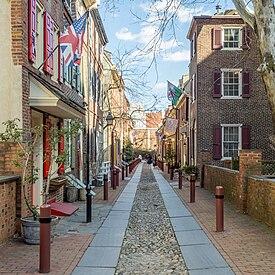Elfreth's Alley is a historic street in the Old City neighborhood of Philadelphia, dating back to 1703.[2] The street has 32 houses, built between 1703 and 1836. The Elfreth's Alley Museum is located at #124 and 126.[2][3] The alley, a National Historic Landmark, runs from North Front to North 2nd streets, paralleling Arch and Quarry streets.
 Elfreth’s Alley in the Old City section of Philadelphia in 2024 | |
| Namesake | Jeremiah Elfreth |
|---|---|
| Type | Alley |
| Area | approx. 40,000 square feet (3,700 m2) |
| Location | Philadelphia, Pennsylvania, U.S. |
| Postal code | 19106 |
| West end | N. 2nd St |
| East end | N. Front St |
| Other | |
| Known for | "Our nation's oldest residential street" |
| Website | www |
Elfreth's Alley Historic District | |
| Coordinates | 39°57′10″N 75°08′33″W / 39.9528°N 75.1425°W |
| Built | 1703 (founded) 1720–1836 (houses built) |
| Architect | multiple |
| NRHP reference No. | 66000681[1] |
| Significant dates | |
| Added to NRHP | October 9, 1960 |
| Designated NHLD | October 9, 1960 |
History
editElfreth's Alley is named after Jeremiah Elfreth, an 18th-century blacksmith and property owner. Among the alley's residents were tradesmen and their families, including shipwrights, silver and pewter smiths, glassblowers, and furniture builders. During the 1770s, one-third of the households were headed by women. The Georgian and Federal-style houses and cobblestone pavement of the alley were common in Philadelphia during this time. The houses are typically small, and many are uniquely Philadelphian Trinity houses.[4]
In the late 19th and early 20th centuries, industry began to change the street. Perhaps the first change was a stove factory that took its place in a row of residential houses in 1868. Eventually, factories surrounded Elfreth's Alley. The city's waterfront was only a few blocks away. Industry changed more than the architecture; successive waves of immigrants, lured by the nearby jobs, moved onto the street. In 1900, the neighborhood was overwhelmingly Irish.
In 1934, the Elfreth's Alley Association (EAA) was founded to preserve the alley's historic structures while interpreting the street's history. The EAA helped save the street from demolition due to Interstate-95 construction in the late 1950s.[5] It also lobbied the city to restore the alley's name to "Elfreth's Alley"; it had been designated as the 100 block of Cherry Street years before as part of a street-name simplification program.
Elfreth's Alley is today the product of cycles of urban renewal and decay, and historic preservation efforts. The alley is a tourist attraction and a rare surviving example of 18th-century working-class housing stock. The site stands in sharp contrast to the more frequently preserved grand mansion houses of Philadelphia's Society Hill neighborhood.
Elfreth's Alley Museum
editElfreth's Alley Museum, located in 124–126 Elfreth's Alley, preserves the 18th-century home of a pair of dressmakers. Restored to its appearance in the Colonial era, exhibits in the house and tour guides interpret the life of the house and alley's residents in that era.[6] Guides also discuss other houses on the alley and their inhabitants.
Holiday celebrations
editThe Elfreth's Alley Association holds several holiday celebrations each year, whose proceeds support the upkeep and restoration of older homes.
For more than seventy years, Elfreth's Alley has celebrated "Fête Day" in early June, which celebrates the Alley's diverse ethnic heritage.[7][8] Residents open their private homes to the public, and are accompanied by historical reenactments and festivities. The Brandywine Heights High School Band and their Fife and Drum Corps perform 18th-century fife tunes as they parade through the alley.[9]
Sometime around the year 2000, Elfreth's Alley started holding "Deck the Alley" early every December, a self-guided tour of thirteen private homes festooned with Christmas and holiday decorations, and also includes caroling.[10] The Alley also hosts events for Fourth of July, Oktoberfest, and Halloween.
See also
editReferences
edit- ^ "National Register Information System". National Register of Historic Places. National Park Service. January 23, 2007.
- ^ a b Historical marker on Elfreth's Alley
- ^ Elfreth's Alley Association website. Other United States localities with three-century-old continuously inhabited homes include Santa Fe, New Mexico; various pueblos; and St. Augustine, Florida.
- ^ Khederlan, Robert (December 14, 2017). "The history of Philadelphia's trinity houses". Curbed. Vox Media. Retrieved March 1, 2021.
- ^ "Elfreth's Alley". Encyclopedia of Greater Philadelphia. Retrieved November 26, 2023.
- ^ "Museum". Elfreth's Alley Association. Retrieved December 21, 2014.
- ^ Caroulis, Jon (July 4, 2023). "Elfreth's Alley Philadelphia: Living on the nation's oldest street — or one of them". Billy Penn at WHYY. Retrieved November 25, 2023.
- ^ ""75th Annual Fete Day- Tickets On Sale Now." Elfreth's Alley". Archived from the original on April 29, 2010. Retrieved April 20, 2010.
- ^ "Feteing Fifes." Concerned Parents of Brandywine Heights. 7 June 2006. [1] Archived 2010-07-26 at the Wayback Machine
- ^ "Yuletide Spirit on Elfreth's Alley". December 7, 2009.
External links
edit- Elfreth's Alley Association
- Historic American Buildings Survey (HABS) No. PA-1103, "Elfreth's Alley (Houses)", 10 photos, 19 measured drawings, 1 photo caption page
- Historic American Buildings Survey (HABS) No. PA-1413, "Jeremiah Elfreth House", 6 photos, 1 photo caption page
